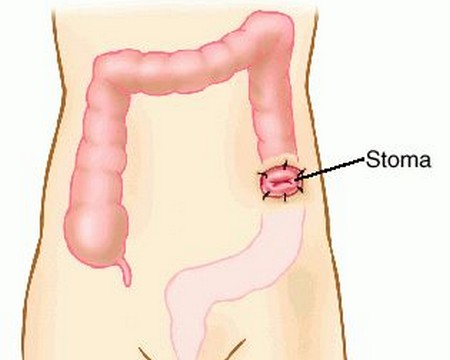In the treatment of certain diseases of the digestive tract, it may become necessary to remove part of the tract. Whenever possible the two cut ends of the tract are sewn together to maintain a passageway for food and waste materials. When this is not possible, an artificial opening (or stoma) is made in the abdominal wall through which waste material can pass into a bag. The care a stoma can be done by a RN or a medical assistant so that the bag doesn’t overflow and cause any type of infection to surrounding area.
Colostomy
A colostomy is when the contents of the colon are made to bypass the rectum and the colon is brought on to the surface of the abdomen. The faeces then pass through an opening in the abdominal wall. They are fairly firm and their consistency can be controlled with diet and medicines. The patient may wear a bag and belt underneath his clothing, but once the stools are formed and regular, he may manage with just a dry dressing over the opening, exchanging this for a bag only when a bowel movement is expected. A well-regulated colostomy acts once a day: the patient can deal with it as if it were a normal rectal opening and then forget about it.
Ileostomy
The ileostomy is when part of the small intestine, the ileum, is brought on to the surface of the abdomen. This is much higher up the gut than a colostomy and the faeces passed are much more fluid. The patient requires a bag permanently in position; it must be leak-proof, unobtrusive under clothing and easy to deal with.
The stoma
When the intestine is brought on to the surface of the abdomen to create a stoma, a small section of gut is left protruding. The colostomy bag fits over this, and may be worn permanently. Some patients wear a special belt that supports the bag, others use a type of bag that attaches to the skin’ around the stoma with an adhesive flange.
Anyone seeing a stoma for the first time may feel revolted by it. This includes the family, the volunteer and the patient. Everyone feels distaste for the abnormal, and the idea of faeces being discharged on to the abdominal wall is abnormal.
The patient is distressed because he lacks bowel control; he is anxious in case he gives offence through odour or by soiling his clothes and he is embarrassed in case his appliance shows through his clothing. Relatives and friends may not be quite sure how to treat the patient: should you ignore the condition or try to offer sympathy? A simple acceptance of the situation often helps the patient most. The volunteer should be sensitive to the patient’s feelings and in no way show any distaste. Gentle and confident handling will make the patient feel that this is a routine procedure and no more unusual than giving a bedpan.
Before leaving hospital, a suitable appliance is selected. Advice will be given about skin care, control of the diet, and the disposal of bags. Once controlled, the stoma should present no special problem as long as it is attended to once a day.
Ensure that the patient can deal with his stoma in privacy if he cannot go to the bathroom. He will need a bowl of warm water, soap and a towel to wash and dry the surrounding area; he should also have a paper bag in which to dispose of the full bag, and a fresh one to take its place.
When the patient has finished, remove the tray and dispose of the faeces by cutting across the top of the bag and emptying its contents into the lavatory. A pair of scissors should be kept separate for this purpose; they should be washed and dried after use. The bag can be wrapped in newspaper, burned or placed in the dustbin. In many areas special chemically treated boxes are supplied for the used bags; when the box is full, it can be sealed and placed in the dustbin. Give the patient a fresh bowl to wash his hands when he has finished.
Patients become very skilled at adjusting their own diets and protecting their skin from damage. If there are any problems consult the family doctor or community nursing sister. There are also specialist societies who can give help and support.
